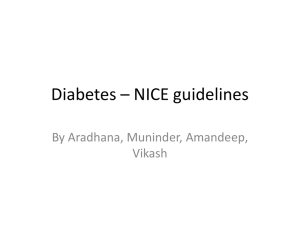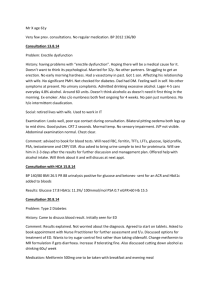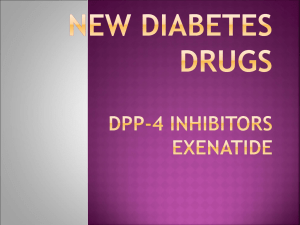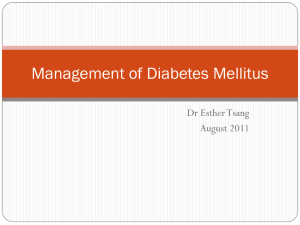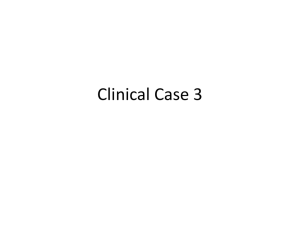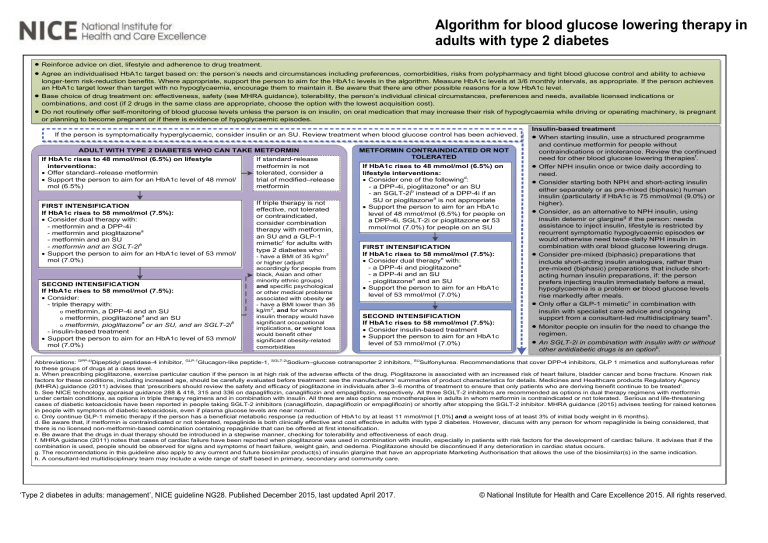
Algorithm for blood glucose lowering therapy in adults with type 2 diabetes · · · · Reinforce advice on diet, lifestyle and adherence to drug treatment. Agree an individualised HbA1c target based on: the person’s needs and circumstances including preferences, comorbidities, risks from polypharmacy and tight blood glucose control and ability to achieve longer-term risk-reduction benefits. Where appropriate, support the person to aim for the HbA1c levels in the algorithm. Measure HbA1c levels at 3/6 monthly intervals, as appropriate. If the person achieves an HbA1c target lower than target with no hypoglycaemia, encourage them to maintain it. Be aware that there are other possible reasons for a low HbA1c level. Base choice of drug treatment on: effectiveness, safety (see MHRA guidance), tolerability, the person’s individual clinical circumstances, preferences and needs, available licensed indications or combinations, and cost (if 2 drugs in the same class are appropriate, choose the option with the lowest acquisition cost). Do not routinely offer self-monitoring of blood glucose levels unless the person is on insulin, on oral medication that may increase their risk of hypoglycaemia while driving or operating machinery, is pregnant or planning to become pregnant or if there is evidence of hypoglycaemic episodes. If the person is symptomatically hyperglycaemic, consider insulin or an SU. Review treatment when blood glucose control has been achieved. ADULT WITH TYPE 2 DIABETES WHO CAN TAKE METFORMIN If HbA1c rises to 48 mmol/mol (6.5%) on lifestyle interventions: · Offer standard–release metformin · Support the person to aim for an HbA1c level of 48 mmol/ mol (6.5%) FIRST INTENSIFICATION If HbA1c rises to 58 mmol/mol (7.5%): · Consider dual therapy with: - metformin and a DPP-4i - metformin and pioglitazonea - metformin and an SU - metformin and an SGLT-2ib · Support the person to aim for an HbA1c level of 53 mmol/ mol (7.0%) SECOND INTENSIFICATION If HbA1c rises to 58 mmol/mol (7.5%): · Consider: - triple therapy with: o metformin, a DPP-4i and an SU a o metformin, pioglitazone and an SU a b o metformin, pioglitazone or an SU, and an SGLT-2i - insulin-based treatment · Support the person to aim for an HbA1c level of 53 mmol/ mol (7.0%) If standard-release metformin is not tolerated, consider a trial of modified–release metformin If triple therapy is not effective, not tolerated or contraindicated, consider combination therapy with metformin, an SU and a GLP-1 mimeticc for adults with type 2 diabetes who: - have a BMI of 35 kg/m2 or higher (adjust accordingly for people from black, Asian and other minority ethnic groups) and specific psychological or other medical problems associated with obesity or - have a BMI lower than 35 kg/m2, and for whom insulin therapy would have significant occupational implications, or weight loss would benefit other significant obesity-related comorbidities METFORMIN CONTRAINDICATED OR NOT TOLERATED If HbA1c rises to 48 mmol/mol (6.5%) on lifestyle interventions: · Consider one of the followingd: - a DPP-4i, pioglitazonea or an SU - an SGLT-2ib instead of a DPP-4i if an SU or pioglitazonea is not appropriate · Support the person to aim for an HbA1c level of 48 mmol/mol (6.5%) for people on a DPP-4i, SGLT-2i or pioglitazone or 53 mmol/mol (7.0%) for people on an SU FIRST INTENSIFICATION If HbA1c rises to 58 mmol/mol (7.5%): · Consider dual therapye with: - a DPP-4i and pioglitazonea - a DPP-4i and an SU - pioglitazonea and an SU · Support the person to aim for an HbA1c level of 53 mmol/mol (7.0%) SECOND INTENSIFICATION If HbA1c rises to 58 mmol/mol (7.5%): · Consider insulin-based treatment · Support the person to aim for an HbA1c level of 53 mmol/mol (7.0%) Insulin-based treatment · When starting insulin, use a structured programme and continue metformin for people without contraindications or intolerance. Review the continued need for other blood glucose lowering therapiesf. · Offer NPH insulin once or twice daily according to need. · Consider starting both NPH and short-acting insulin either separately or as pre-mixed (biphasic) human insulin (particularly if HbA1c is 75 mmol/mol (9.0%) or higher). · Consider, as an alternative to NPH insulin, using insulin detemir or glargineg if the person: needs assistance to inject insulin, lifestyle is restricted by recurrent symptomatic hypoglycaemic episodes or would otherwise need twice-daily NPH insulin in combination with oral blood glucose lowering drugs. · Consider pre-mixed (biphasic) preparations that include short-acting insulin analogues, rather than pre-mixed (biphasic) preparations that include shortacting human insulin preparations, if: the person prefers injecting insulin immediately before a meal, hypoglycaemia is a problem or blood glucose levels rise markedly after meals. · Only offer a GLP-1 mimeticc in combination with insulin with specialist care advice and ongoing support from a consultant-led multidisciplinary teamh. · Monitor people on insulin for the need to change the regimen. · An SGLT-2i in combination with insulin with or without other antidiabetic drugs is an optionb. Abbreviations: DPP-4iDipeptidyl peptidase-4 inhibitor, GLP-1Glucagon-like peptide-1, SGLT-2iSodium–glucose cotransporter 2 inhibitors, SUSulfonylurea. Recommendations that cover DPP-4 inhibitors, GLP 1 mimetics and sulfonylureas refer to these groups of drugs at a class level. a. When prescribing pioglitazone, exercise particular caution if the person is at high risk of the adverse effects of the drug. Pioglitazone is associated with an increased risk of heart failure, bladder cancer and bone fracture. Known risk factors for these conditions, including increased age, should be carefully evaluated before treatment: see the manufacturers’ summaries of product characteristics for details. Medicines and Healthcare products Regulatory Agency (MHRA) guidance (2011) advises that ‘prescribers should review the safety and efficacy of pioglitazone in individuals after 3–6 months of treatment to ensure that only patients who are deriving benefit continue to be treated’. b. See NICE technology appraisal guidance 288 & 418, 315 and 336 on dapagliflozin, canagliflozin and empagliflozin, respectively. All three SGLT-2 inhibitors are recommended as options in dual therapy regimens with metformin under certain conditions, as options in triple therapy regimens and in combination with insulin. All three are also options as monotherapies in adults in whom metformin is contraindicated or not tolerated. Serious and life-threatening cases of diabetic ketoacidosis have been reported in people taking SGLT-2 inhibitors (canagliflozin, dapagliflozin or empagliflozin) or shortly after stopping the SGLT-2 inhibitor. MHRA guidance (2015) advises testing for raised ketones in people with symptoms of diabetic ketoacidosis, even if plasma glucose levels are near normal. c. Only continue GLP-1 mimetic therapy if the person has a beneficial metabolic response (a reduction of HbA1c by at least 11 mmol/mol [1.0%] and a weight loss of at least 3% of initial body weight in 6 months). d. Be aware that, if metformin is contraindicated or not tolerated, repaglinide is both clinically effective and cost effective in adults with type 2 diabetes. However, discuss with any person for whom repaglinide is being considered, that there is no licensed non-metformin-based combination containing repaglinide that can be offered at first intensification. e. Be aware that the drugs in dual therapy should be introduced in a stepwise manner, checking for tolerability and effectiveness of each drug. f. MHRA guidance (2011) notes that cases of cardiac failure have been reported when pioglitazone was used in combination with insulin, especially in patients with risk factors for the development of cardiac failure. It advises that if the combination is used, people should be observed for signs and symptoms of heart failure, weight gain, and oedema. Pioglitazone should be discontinued if any deterioration in cardiac status occurs. g. The recommendations in this guideline also apply to any current and future biosimilar product(s) of insulin glargine that have an appropriate Marketing Authorisation that allows the use of the biosimilar(s) in the same indication. h. A consultant-led multidisciplinary team may include a wide range of staff based in primary, secondary and community care. ‘Type 2 diabetes in adults: management’, NICE guideline NG28. Published December 2015, last updated April 2017. © National Institute for Health and Care Excellence 2015. All rights reserved.
